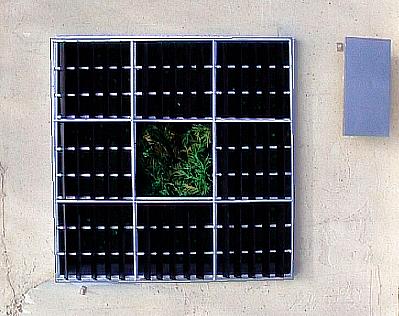| |
Strength in unity. |
|
|
|
Once the trees have reached a height of 8
m, the roof may be removed, as long as the system has reached a stability
within its surroundings. The time required for this first growth period is
estimated to be about 4 or 5 years.
The criteria for selection of
palms are, one, fast growth rate and second, root development. The roots should
extend deep and wide in the sand. At maturity they should reach a final height
of 8 to 10 m. After the development is complete work may be started on
neighbouring cells so that the total area covered reaches 48 x 48m. The
new cells are then started in the same manner as described above. |
|
Drawing 3:
 |
|
| A) After 4 years |
|
What is important is that the
cultivated area be regarded as a complete unit. The narrowest part should not
be smaller than 48m. After 4 years growth, up to 256 square metres of
woods are created.
In a model which we have made the total area
would look something like this after 4 years: |
|
Picture 4:
 |
|
| The cell system has then a
total area of 2304 square metres. The solar roof can be removed in the middle
section after 4 years. Leafgrowth and spread of plants provide enough shadow
for the needs of this cell. The outlying cells need the regulating roof for the
next 4 years. Beside the cell system is the housing for personal and technical
instruments. Picture 5 shows a detail of the model after 4 years
development. |
|
Picture 5:
 |
|
| B) After 8 years |
|
| In the surrounding new cells,
as in the first cells, new palms, adaptable bushes and shrubs are planted.
After 4 years, the inner dividing walls may be removed, so that the size of the
cell has increased to 48 x 48m. The digging out of the cell, planting of
greenery and erection of the cell roof should be timed so that a drying out of
the ground is avoided. Rooves can be removed and then immediately mounted in
nearby new cells where they are directly needed. |
|
| C) After 12 years |
|
| After a development period of
about 12 years it is estimated that a total area of up to 6,4 square
kilometres woods can be created when 1000 cells are simultaneously started.
In some areas the groundwater may not come high enough to serve the plants.
Such an unevenness of the groundwater can be catered for with solar powered
water pumps planted deep in the ground. |
|
| D) In the end life
wins |
|
| Forests have a great natural
power as long as they can grow in one group and are protected from the sides
(through the surrounding trees and walls). This power grows as the forest
grows. In the process described by James Lovelock of a wood near Harappa in
Pakistan the influence of the wood increases with its own growth. The aim is to
cause local climate changes so that the rainfall increases, the ground
temperature decreases and the forest arrives at a point in its development
where its daily expansion is greater than the increase in desertification at
this location. After a further 12 years with the help of the described cell
reproduction, the forest may reach a size of 30 square kilometres. From this
point then the power of the forest should have reached a size of effectibility.
That is to say it now influences the weather rather than only being subject to
weather changes. |
|
| less |
|
more |


